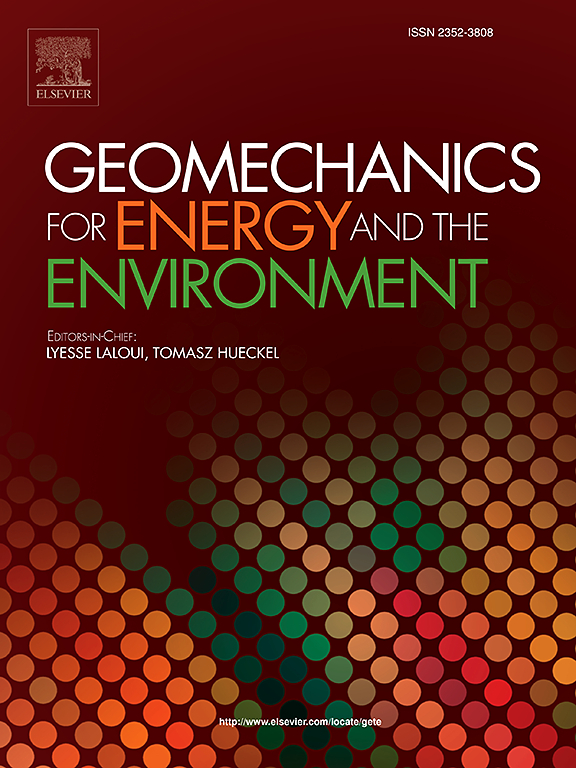不同等级煤在 LN2 冻融过程中的传热变形特征和断裂损伤分析
IF 3.7
2区 工程技术
Q3 ENERGY & FUELS
引用次数: 0
摘要
探索不同煤级煤体在冻融过程中的传热和变形特征,对于分析液氮(LN2)作用下的断裂机理具有重要意义。本实验针对饱和和干燥条件下的褐煤、沥青和无烟煤。采用实时温度-应变监测系统观察不同等级煤样在整个冻融循环过程中的传热和变形特性。此外,还利用核磁共振系统研究了压裂前后孔隙损伤的特征。研究结果表明:(1)在冻融过程中,干燥煤样的温度演化率绝对值与煤的等级呈负相关,表明温度扩散与煤的固有特性(如含氧量和孔隙率)密切相关。(2)对于饱和煤样,冻结过程中温度变化率的绝对值随着煤炭等级的增加而降低,在解冻过程中则呈现相反的趋势。冻结时裂隙中的水的相变效应可以增强煤体内部的温度扩散,而在解冻时则起到抑制作用。(3)根据应变波动趋势,可将冻融循环期间的煤体变形过程划分为七个阶段,总结出变形破坏的一般机理。(4)在饱和条件下,各煤样的弹性变形幅度与煤的等级呈负相关,干煤样的顺序为烟煤> 无烟煤> 褐煤。(5) 冻结初期密封空间的形成被认为是冻融过程中变形的必要条件,密封空间的形成和强度取决于温度扩散速率、含水量和煤样的固有特性。本文章由计算机程序翻译,如有差异,请以英文原文为准。
Heat transfer-deformation characteristics and fracture damage analysis during LN2 freeze-thaw process in different rank coals
Exploring the heat transfer and deformation characteristics of coal bodies of different coal ranks during the freeze-thaw process is of significant importance for analyzing the fracture mechanism under the effect of liquid nitrogen (LN2). This experiment targets lignite, bituminite, and anthracite under both saturated and dry conditions. A real-time temperature-strain monitoring system was employed to observe the heat transfer and deformation characteristics of coal samples with different ranks throughout the freeze-thaw cycle. Additionally, a nuclear magnetic resonance system was utilized to examine the characteristics of pore damage before and after fracturing. The findings reveal: (1) During the freeze-thaw process, the absolute value of the temperature evolution rate for dry coal samples shows a negative correlation with coal rank, indicating a close link between temperature diffusion and intrinsic coal properties like oxygen content and porosity. (2) For saturated coal samples, the absolute value of the temperature change rate during freezing decreases as the coal rank increases, with the opposite trend observed during thawing. The phase change effect of water in fractures during freezing can enhance internal temperature diffusion in the coal body, while it acts as an inhibitor during thawing. (3) Based on the trend of strain fluctuations, the coal body deformation process during the freeze-thaw cycle can be segmented into seven stages, summarizing the general mechanisms of deformation failure. (4) Under saturated conditions, the amplitude of elastic deformation for each sample is negatively correlated with coal rank, with the sequence for dry coal samples being bituminite > anthracite > lignite. (5) The formation of a sealed space at the beginning of freezing is identified as a necessary condition for deformation during the freeze-thaw process, with the formation and strength of the sealed space depending on the temperature diffusion rate, moisture content, and inherent properties of the coal sample.
求助全文
通过发布文献求助,成功后即可免费获取论文全文。
去求助
来源期刊

Geomechanics for Energy and the Environment
Earth and Planetary Sciences-Geotechnical Engineering and Engineering Geology
CiteScore
5.90
自引率
11.80%
发文量
87
期刊介绍:
The aim of the Journal is to publish research results of the highest quality and of lasting importance on the subject of geomechanics, with the focus on applications to geological energy production and storage, and the interaction of soils and rocks with the natural and engineered environment. Special attention is given to concepts and developments of new energy geotechnologies that comprise intrinsic mechanisms protecting the environment against a potential engineering induced damage, hence warranting sustainable usage of energy resources.
The scope of the journal is broad, including fundamental concepts in geomechanics and mechanics of porous media, the experiments and analysis of novel phenomena and applications. Of special interest are issues resulting from coupling of particular physics, chemistry and biology of external forcings, as well as of pore fluid/gas and minerals to the solid mechanics of the medium skeleton and pore fluid mechanics. The multi-scale and inter-scale interactions between the phenomena and the behavior representations are also of particular interest. Contributions to general theoretical approach to these issues, but of potential reference to geomechanics in its context of energy and the environment are also most welcome.
 求助内容:
求助内容: 应助结果提醒方式:
应助结果提醒方式:


